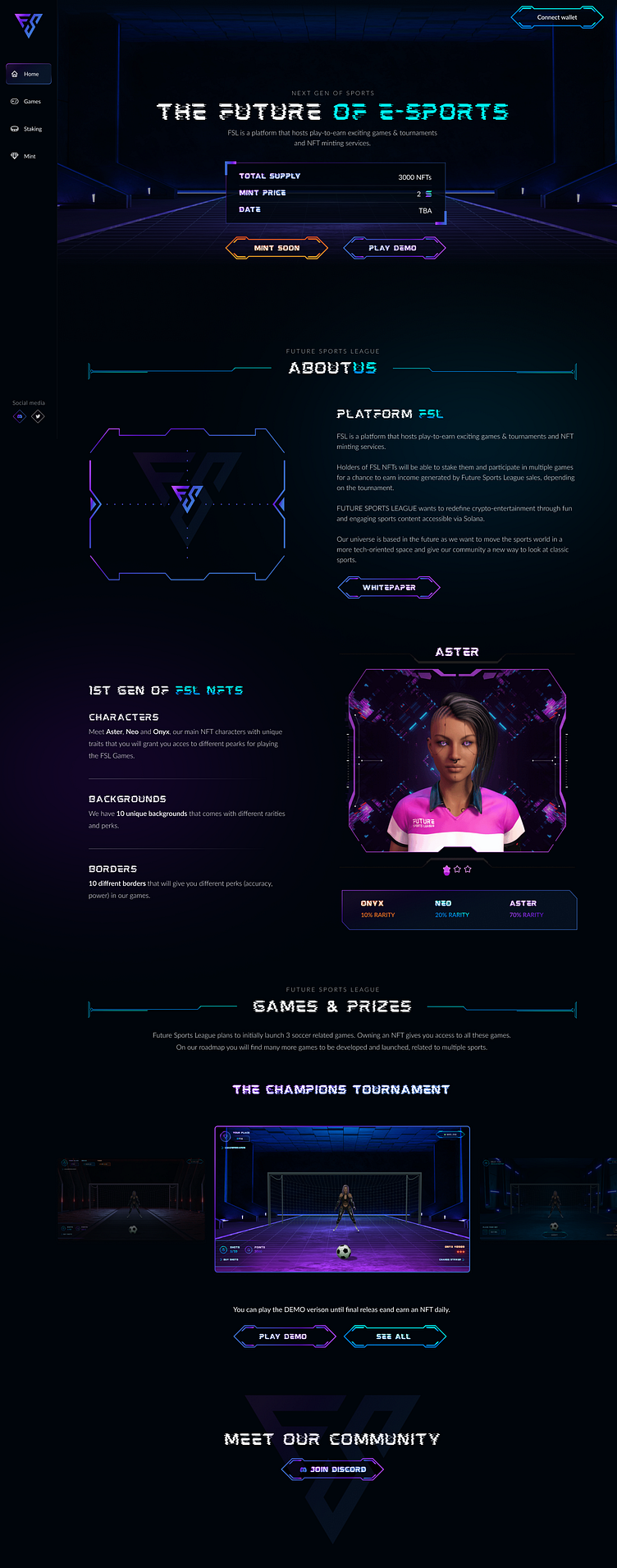Feature Sports League - NFT Game
Introduction: Future Sports League is a cutting-edge NFT platform that aims to revolutionize the world of sports and entertainment through the integration of blockchain technology. The platform enables users to participate in decentralized autonomous organization (DAO) games, where they can stake their NFT assets, compete against other players, and earn rewards.
Problem Statement: The existing NFT platforms lack a cohesive and user-friendly interface for users to engage in DAO games, stake their assets, and understand the reward system. Future Sports League seeks to address these challenges by providing an intuitive and visually appealing UX/UI design that enhances user experience and promotes user engagement.
Design Goals:
User-Friendly Interface: Create a user-friendly interface that allows both experienced and novice users to easily navigate the platform, understand game mechanics, and stake their assets without any confusion.
Visual Appeal: Develop an aesthetically pleasing UI design that aligns with the futuristic and sports-themed branding of the platform, attracting and retaining users.
Clarity and Transparency: Ensure transparency in the reward system and clearly communicate the rules, staking mechanisms, and game progress to build trust among users.
Efficient Interaction: Optimize the user flow and interaction design to minimize friction, reduce cognitive load, and enhance overall efficiency.
Responsive Design: Create a responsive design that provides a consistent experience across multiple devices, including desktop, mobile, and tablets.
User Research: To gain insights into the target users and their needs, conduct user research through surveys and interviews. Identify the target audience, their preferences, pain points, and expectations when participating in DAO games and staking assets. Collect feedback from early adopters and incorporate their suggestions into the design process.
User Personas:
Sports Enthusiast: A passionate sports lover who is interested in both physical and virtual sports. They enjoy the competitive nature of sports and are eager to participate in DAO games to showcase their skills and win rewards.
Crypto Enthusiast: An experienced crypto user who is knowledgeable about blockchain technology and NFTs. They are excited about the potential of combining NFTs with sports and seek a user-friendly platform to stake their assets and engage in DAO games.
Casual Gamer: A casual gamer who is relatively new to blockchain and NFTs but enjoys playing games for entertainment. They are attracted to the concept of earning rewards and want an intuitive platform that makes it easy for them to get started.
1. Onboarding: To provide a smooth onboarding experience for new users:
Implement a guided onboarding process that educates users about NFTs, blockchain, and the platform's functionalities.
Simplify the registration process by enabling social media authentication or email sign-up options.
Offer a comprehensive tutorial that showcases the platform's features, game mechanics, and staking process.
2. Dashboard: Design an interactive and informative dashboard to serve as the central hub for users:
Display a personalized dashboard that shows users their NFT assets, current stakes, rewards earned, and overall performance.
Provide an overview of the available DAO games, upcoming events, and popular games to encourage participation.
Include a search and filter functionality for users to find specific games or NFT assets.
3. Game Exploration: Enable users to explore and select DAO games based on their interests:
Create a categorized game library that showcases different sports genres and game types.
Display game descriptions, rules, and rewards to help users make informed decisions.
Implement a rating and review system for users to share their experiences and help others in choosing games.
Staking Process: Streamline the staking process and ensure clarity in asset management:
Provide a user-friendly interface for users to stake their NFT assets to participate in DAO games.
Clearly communicate the staking requirements, potential rewards, and any associated risks.
Include a dashboard section dedicated to managing staked assets, allowing users to track their performance and make informed decisions.
5. Reward System: Communicate the reward system effectively to enhance user motivation and engagement:
Provide real-time updates on rewards earned and display them prominently in the user's dashboard.
Include a rewards history section where users can view past rewards, track their progress, and understand how they were calculated.
Integrate a leaderboard to showcase the top performers and incentivize healthy competition.





